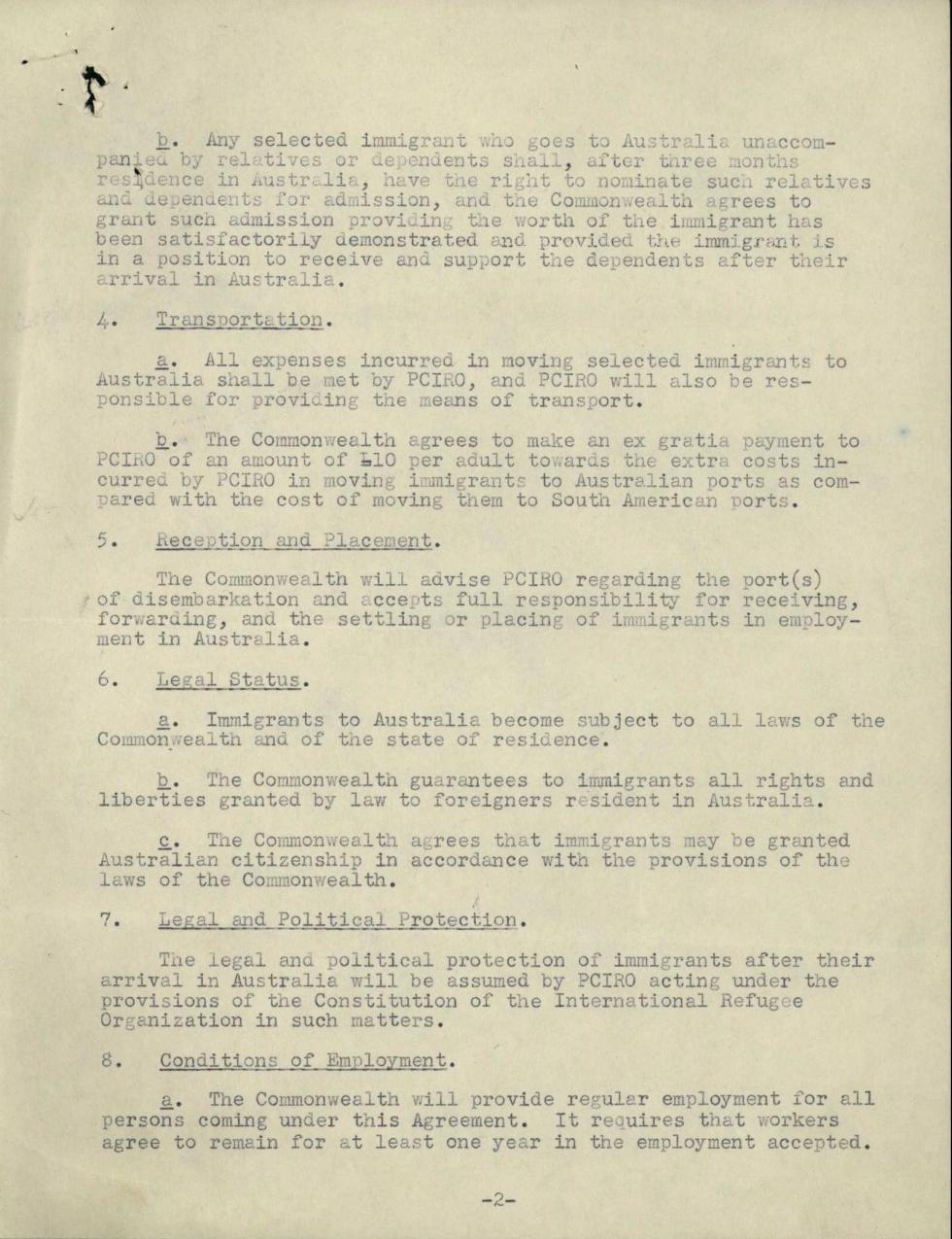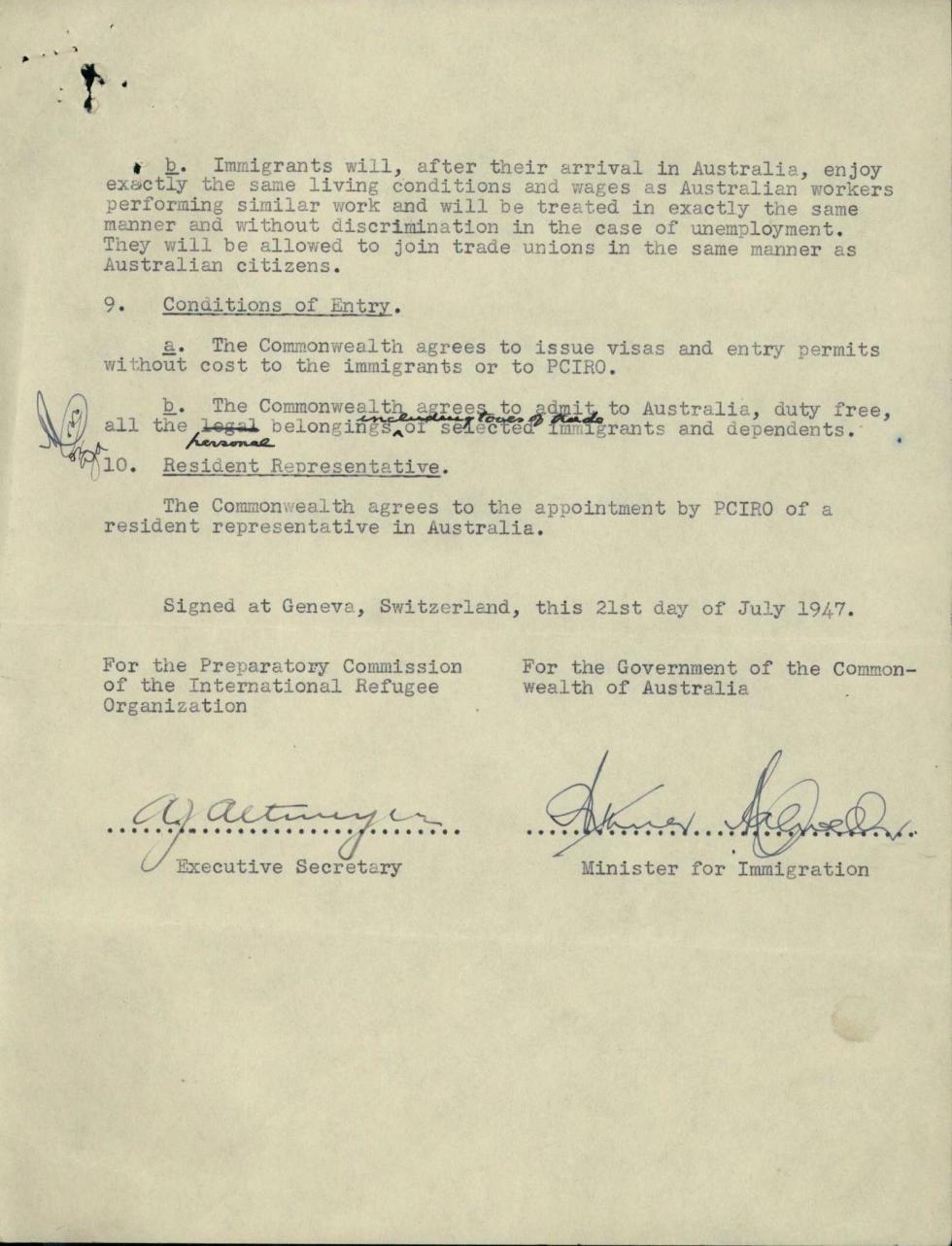


Aboriginal and Torres Strait Islander people should be aware that the National Archives' website and collection contain the names, images and voices of people who have died.
Some records include terms and views that are not appropriate today. They reflect the period in which they were created and are not the views of the National Archives.




[page 1]
[top right corner, handwritten, pencil] 46-2 [end handwritten]
[Heading] AGREEMENT [underlined, capitalised]
Between the Government of the Commonwealth of Australia and the Preparatory Commission of the International Refugee Organisation
The Government of the Commonwealth of Australia (herein-after referred to as the Commonwealth) and the Preparatory Commission of the International Refugee Organisation (herein-after referred to as PCIRO) have agreed as follows regarding immigration into Australia of Refugees and Displaced Persons within the Meaning of the Resolution adopted by the Economic and Social Council of the United Nations on 16 February 1946.
1. Number and Types of Immigrants. [underlined]
a. The Commonwealth will from time to time submit to PCIRO (at Geneva) particulars of the numbers and qualifications of desired immigrants. The first of these lists will be submitted within 30 days after approval of the Agreement.
b. The Commonwealth estimates that during the balance of 1947 the number of workers and dependents desired will approximate a total of 4000 persons.
2. Selection of Immigrants [underlined]
a. The Commonwealth shall have the full right of selection by officers of the Department for Immigration of the Commonwealth and the Commonwealth will advise PCIRO from time to time of the names and functions of officers nominated for this purpose.
b. The Commonwealth agrees that selection of immigrants will be carried out without discrimination as to race or religion.
c. PCIRO agrees to [crossed out, black ink] [handwritten, black ink] will be responsible for instituting [end handwritten] such preliminary selection procedure as may be required by the Commonwealth. [ handwritten signature in left margin]
d. PCIRO reserves the right to allocate the recruitment of immigrants for final selection by officers of the Commonwealth to the various Occupied Zones of Germany and Austria, and to the Middle East, Italy or elsewhere.
3. Relatives and Dependents. [underlined]
a. Heads of family units selected may be accompanied by all members of their immediate family and by such other relatives as are dependent on the head of the family and who live with him. Other causes deserving special consideration from humanitarian standpoints will be examined individually by the Commonwealth.
[end page 1]
[page 2]
b. Any selected immigrants who goes to Australia unaccompanied by relatives or dependents shall, after three months residence in Australia, have the right to nominate such relatives and dependents for admission, and the Commonwealth agrees to grant such admission providing the worth of the immigrant has been satisfactorily demonstrated and provided the immigrant is in a position to receive and support the dependents after their arrival in Australia.
4. Transportation. [underlined]
a. All expenses incurred in moving selected immigrants to Australia shall be met by PCIRO, and PCIRO will also be responsible for providing the means of transport.
b. The Commonwealth agrees to make an ex gratia payment to PCIRO of an amount of Ɫ10 per adult towards the extra costs incurred by PCIRO in moving immigrants to Australian ports as compared with the cost of moving them to South American ports.
5. Reception and Placement. [underlined]
The Commonwealth will advise PCIRO regarding the port(s) of disembarkation and accepts full responsibility for receiving, forwarding, and the settling or placing of immigrants in employment in Australia.
6. Legal Status. [underlined]
a. Immigrants to Australia become subject to all laws of the Commonwealth and of the state of residence.
b. The Commonwealth guarantees to immigrants all rights and liberties granted by law to foreigners' resident in Australia.
c. The Commonwealth agrees that immigrants may be granted Australia citizenship in accordance with the provisions of the laws of the Commonwealth.
7. Legal and Political Protection. [underlined]
The legal and political protection of immigrants after their arrival in Australia will be assumed by PCIRO acting under the provisions of the Constitution of the International Refugee Organisation in such matters.
8. Conditions of Employment. [underlined]
a. The Commonwealth will provide regular employment for all persons coming under this Agreement. It requires that workers agree to remain for at least one year in the employment accepted.
-2-
[end page 2]
[page 3]
b. Immigrants will, after their arrival in Australia, enjoy exactly the same living conditions and wages as Australian workers performing similar work and will be treated in exactly the same manner and without discrimination in the case of unemployment. They will be allowed to join trade unions in the same manner as Australian citizens.
9. Conditions of Entry. [underlined]
a. The Commonwealth agrees to issue visas and entry permits without the cost to the immigrants or to PCIRO.
b. The Commonwealth agrees to admit to Australia, duty free, all the legal [end crossed out, black ink] [handwritten, black ink] personal [end of handwritten] belongings [Handwritten] including tools of trade [end of handwritten] of selected immigrants and dependents. [handwritten signature in the left margin]
10. Resident Representative. [underlined]
The Commonwealth agrees to the appointment by PCIRO of a resident representative in Australia.
Signed at Geneva, Switzerland, this 21st day of July 1947.
For the Preparatory Commission of the International Refugee Organization
[A J Altmeyer handwritten signature]
Executive Secretary
For the Government of the Commonwealth of Australia
[Arthur Calwell handwritten signature]
Minister for Immigration
This is an agreement about the migration, to Australia, of thousands of people in Europe who had become displaced because of the Second World War (WW2). It was signed on 21 July 1947 in Geneva by the Australian Government and the Preparatory Commission of the International Refugee Organisation. The three-page agreement outlines details of the numbers of immigrants, their legal status and their living conditions in Australia. The signatures of both parties can be found at the end of the agreement. There are also two sections where handwritten changes have been made to the typed agreement and initialled by both parties.
Learn how to interpret primary sources, use our collection and more.
